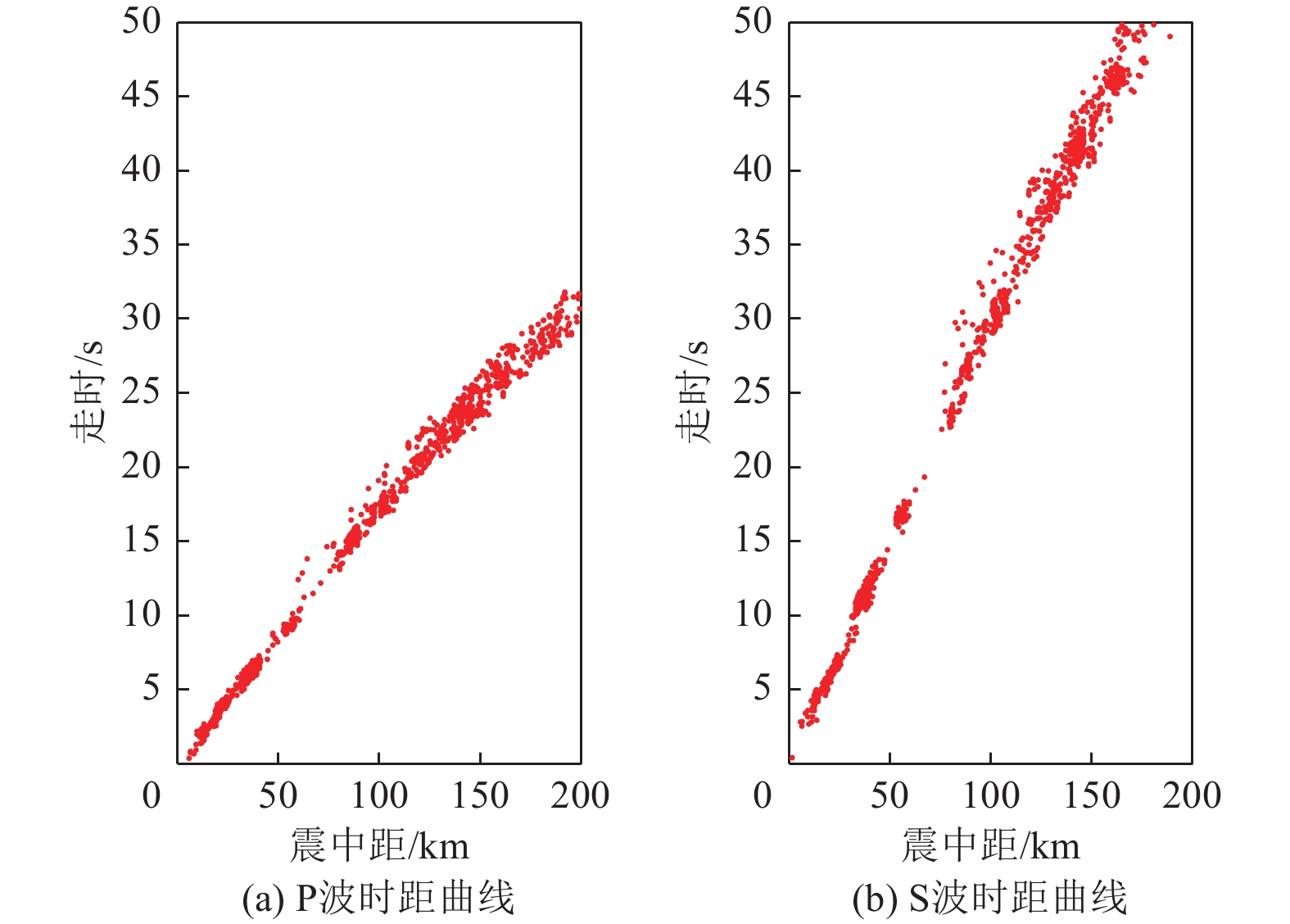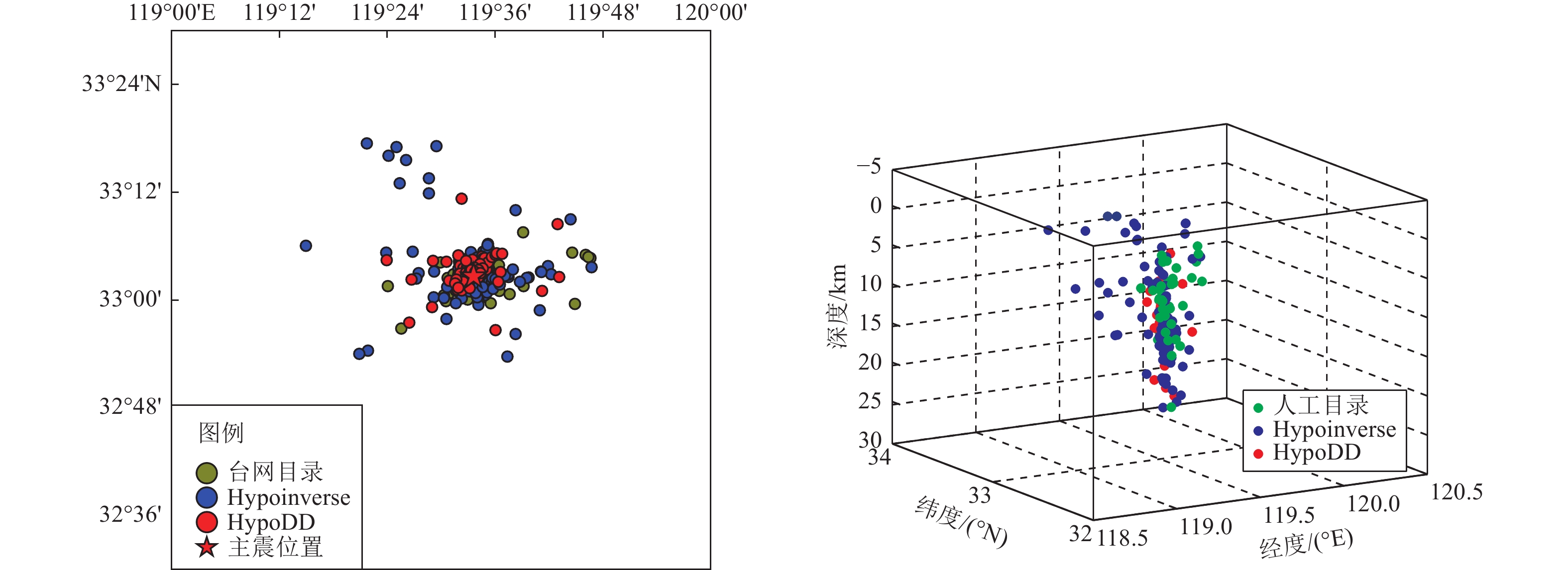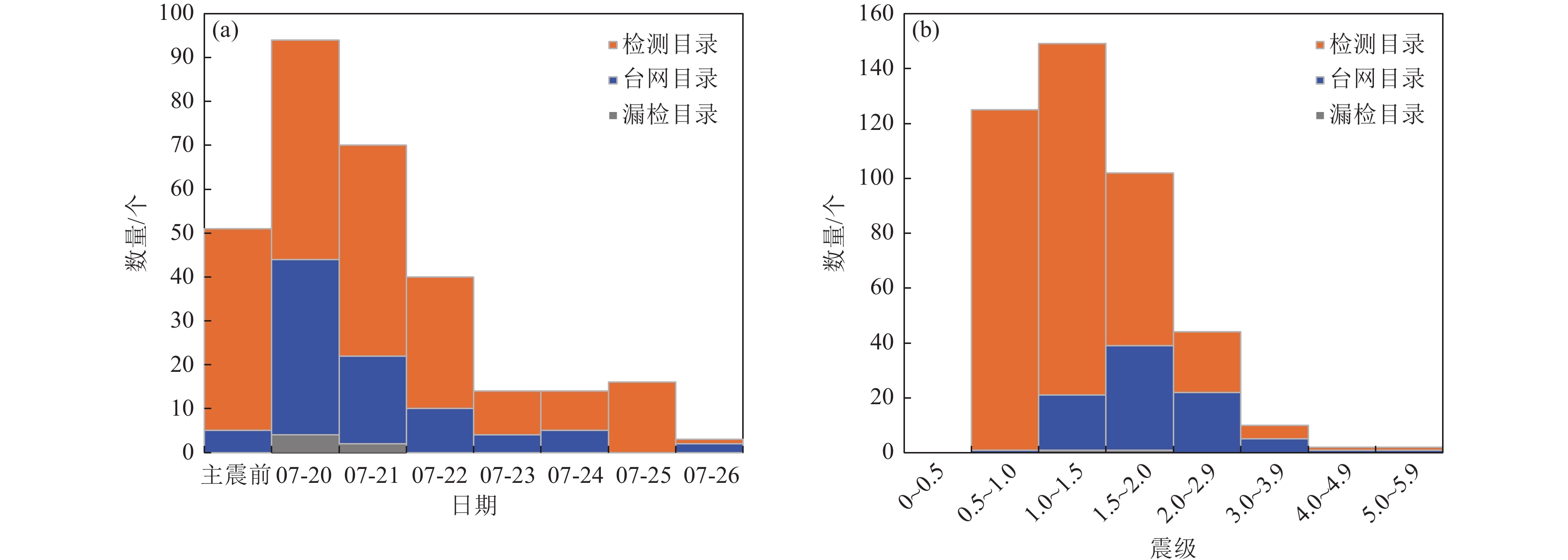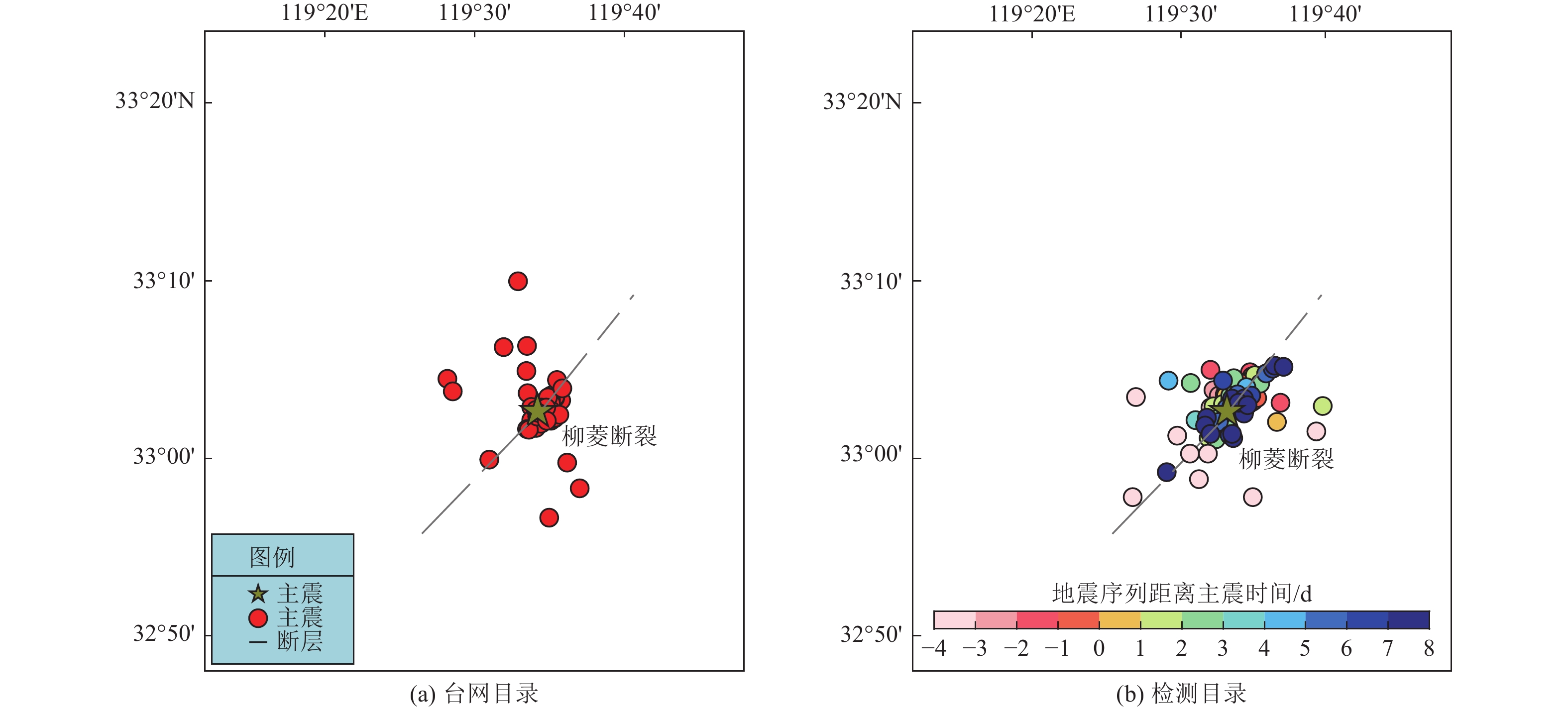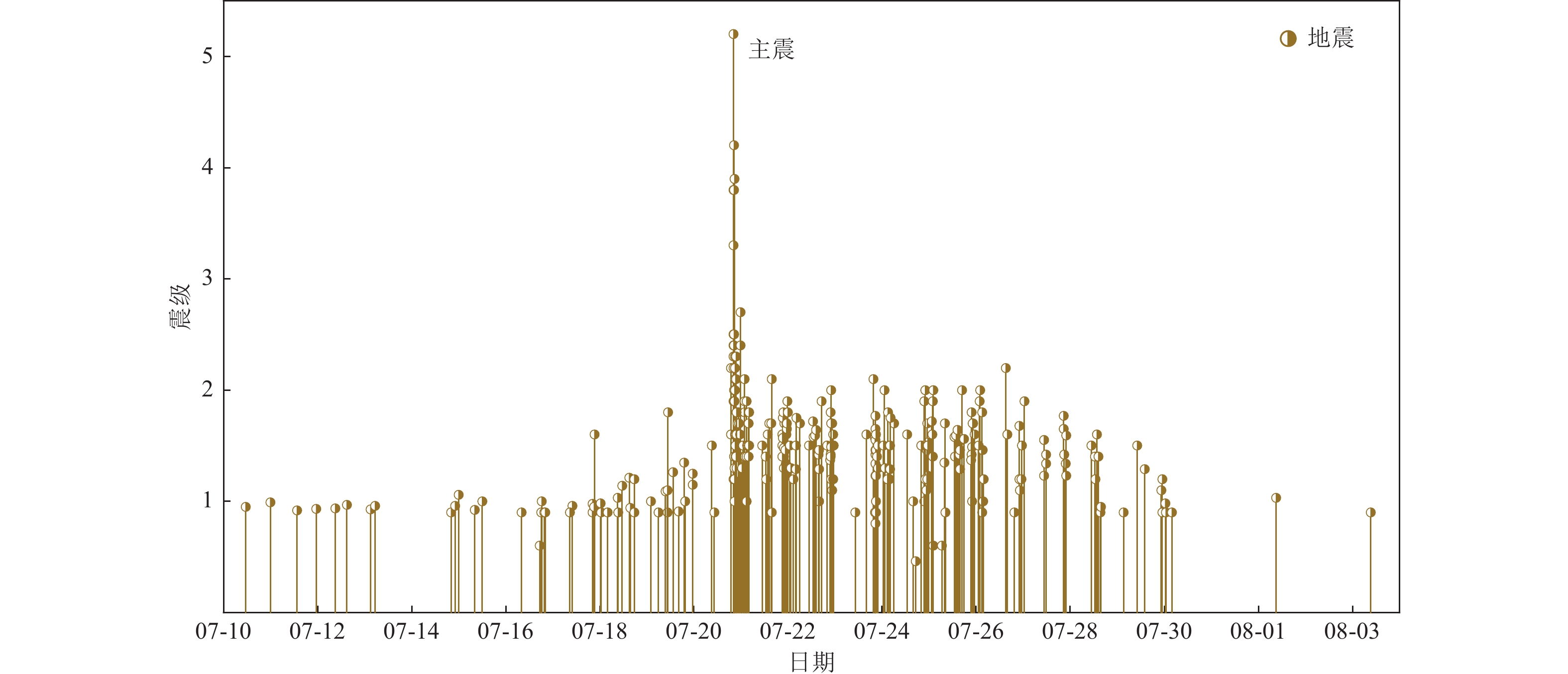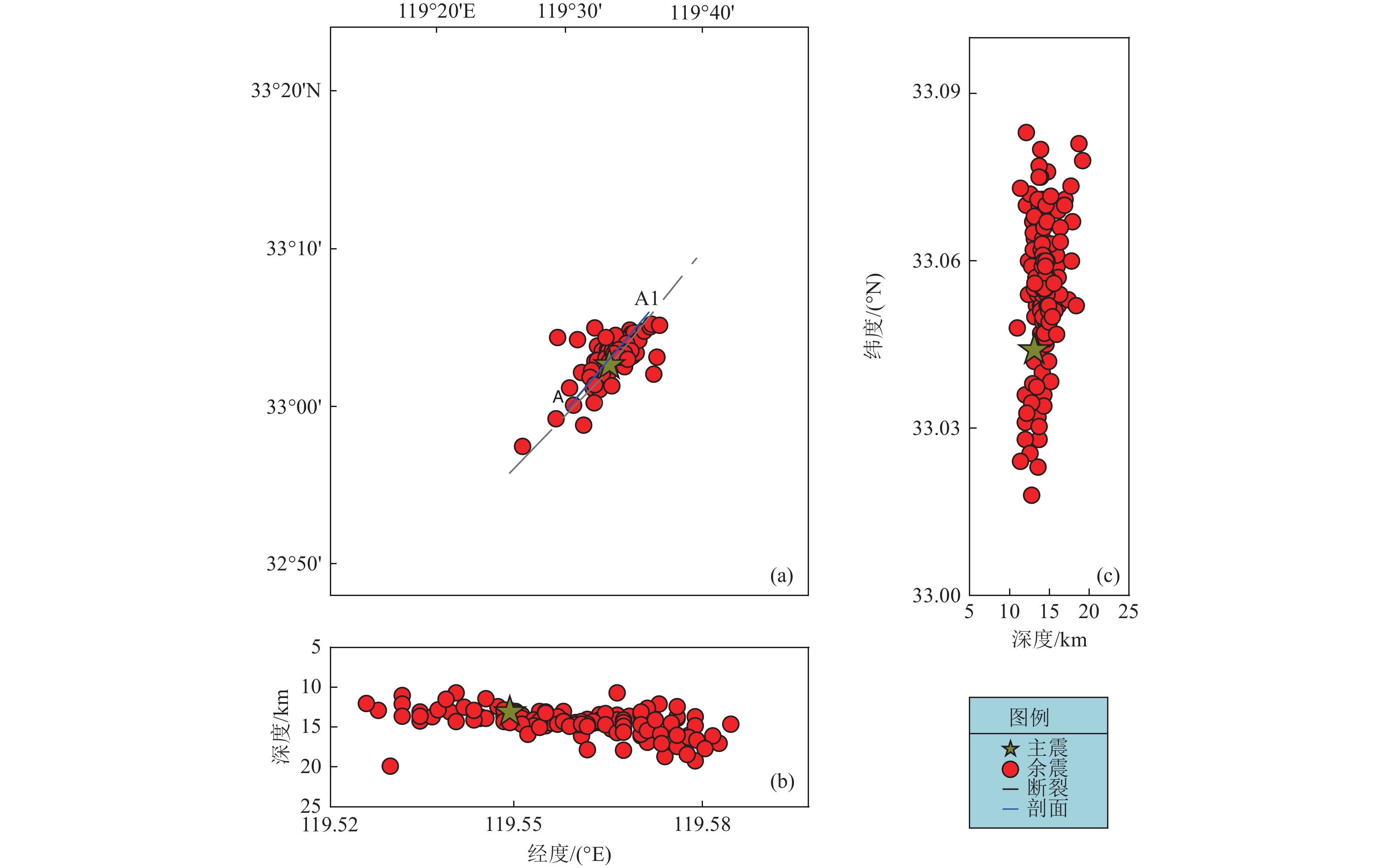Microseismic Detection and Precise Relocation of 2012 Gaoyou-Baoying M4.9 Earthquake Sequence in Jiangsu
-
摘要: 本文利用江苏地区44个固定台站和4个流动台站的观测数据,采用基于人工智能的PhaseNet震相检测法,对2012年江苏高邮-宝应M4.9地震前后30d的连续数据进行地震检测,并开展REAL震相关联、绝对定位以及HypoDD精定位研究工作,获得了此次地震序列的完整目录。研究结果表明:(1)PhaseNet检测后的地震目录数量为342个,是江苏台网人工测定地震目录数量的3.7倍,震级分布范围为ML0.5~ML5.1;(2)自动检测结果丰富了高邮-宝应ML0.5~ML1.5的地震序列,并在主震前检测到大量前震序列,从主震发生前10d开始,震中区周边出现明显的地震活动增强趋势,主震后7d余震逐渐稀疏趋于平静;(3)精定位后共得到184条高精度地震目录,约为检测前精定位地震数量的3倍,地震序列震源深度主要集中在12~15 km;(4)精定位结果显示本次地震为典型的双向破裂,主震位于剖面的中部偏下位置,地震序列整体呈NNE方向展布,发震断层较为陡峭。综合本文研究、震源机制解以及地质构造资料,推测此次地震的发震断裂为柳菱断裂。
-
关键词:
- PhaseNet震相检测 /
- 精定位 /
- 高邮-宝应M4.9地震 /
- 柳菱断裂
Abstract: IIn this study, we applied PhaseNet, an artificial intelligence–based seismic phase detection method, to analyze 30 days of continuous waveform data from 44 permanent and 4 temporary seismic stations surrounding the 2012 Gaoyou–Baoying M4.9 earthquake in Jiangsu Province. Following detection, we performed phase association using REAL, earthquake location, and precise relocation, ultimately producing a comprehensive catalogue of the earthquake sequence. The main findings are as follows: (1) PhaseNet detected 342 events, which is approximately 3.7 times more than the number recorded in the official Jiangsu Seismic Network catalogue. The detected events range in magnitude from ML 0.5 to ML5.1. (2)The automatic detection significantly enriched the Gaoyou–Baoying seismic sequence, particularly for small-magnitude events ( ML0.5~1.5). A large number of foreshocks were identified preceding the mainshock, with a clear increase in seismic activity within 10 days before the mainshock. In contrast, aftershock activity markedly decreased and became more spatially dispersed within 7 days after the mainshock. (3) After precise relocation, 184 high-precision earthquake events were identified—approximately three times the number of accurately located events prior to this analysis. These events are primarily concentrated at depths of 12~15km. (4)The earthquake sequence exhibits characteristics of bi-directional rupture, with the mainshock occurring in the lower section of the central rupture zone. The sequence aligns along a NNE-trending, steeply dipping fault. Based on the spatial distribution of the seismic sequence, source mechanism solutions, and regional geological data, we infer that the Liuling Fault is the likely seismogenic structure responsible for the 2012 Gaoyou–Baoying M4.9 earthquake. -
表 1 江苏一维速度模型
Table 1. The one-dimensional velocity model in Jiangsu
层深/km VP/(km·s−1) VS/(km·s−1) 0 3.70 2.14 5 5.10 2.92 10 5.44 3.14 15 6.03 3.48 20 6.34 3.66 25 6.52 3.76 40 7.02 4.05 -
蔡明远,2023. 基于深度学习的玛多地区震源位置与三维速度结构研究. 兰州:中国地震局兰州地震研究所.Cai M. Y., 2023. Study on earthquake relocation and three-dimensional velocity structure in the Maduo area based on deep learning. Lanzhou:China Earthquake Administration Lanzhou Institute of Seismology. (in Chinese) 高方鸿,刘志坤,耿传涛,2022. 2020年云南东川ML4.2地震序列精定位研究. 地震研究,45(1):48−53.Gao F. H., Liu Z. K., Geng C. T., 2022. Accurate location of the 2020 Dongchuan, Yunnan ML4.2 earthquake sequence. Journal of Seismological Research, 45(1): 48−53. (in Chinese) 龚丽文,张怀,陈石等,2023. 基于机器学习的长宁地震三维断层面几何特征建模. 地震学报,45(6):1040−1054. doi: 10.11939/jass.20220079Gong L. W., Zhang H., Chen S., et al., 2023. Geometry features modeling of three-dimensional fault plane of Changning earthquake based on machine learning. Acta Seismologica Sinica, 45(6): 1040−1054. (in Chinese) doi: 10.11939/jass.20220079 顾勤平,李大虎,丁志峰等,2022. 利用接收函数研究郯庐断裂带鲁苏皖段及邻区地壳结构特征. 地球物理学报,65(9):3280−3296. doi: 10.6038/cjg2022P0926Gu Q. P., Li D. H., Ding Z. F., et al., 2022. Crustal structure characteristics beneath the Shandong-Jiangsu-Anhui segment of the Tan-Lu fault zone and its adjacent regions using receiver functions. Chinese Journal of Geophysics, 65(9): 3280−3296. (in Chinese) doi: 10.6038/cjg2022P0926 洪德全,王行舟,倪红玉等,2013. 多种方法研究2012年7月20日江苏高邮MS4.9级地震震源机制解和震源深度. 地球物理学进展,28(4):1757−1765. doi: 10.6038/pg20130416Hong D. Q., Wang X. Z., Ni H. Y., et al., 2013. Focal mechanism and focal depth of July 20, 2012 Jiangsu Gaoyou MS4.9 earthquake. Progress in Geophys, 28(4): 1757−1765. (in Chinese) doi: 10.6038/pg20130416 洪海春,杨伟林,彭小波等,2013. 江苏高邮、宝应MS4.9级地震现场震害调查与破坏原因研究. 震灾防御技术,8(3):283−291. doi: 10.3969/j.issn.1673-5722.2013.03.007Hong H. C., Yang W. L., Peng X. B., et al., 2013. Field investigation and research on damage cause of Gaoyou-Baoying MS4.9 earthquake in Jiangsu Province. Technology for Earthquake Disaster Prevention, 8(3): 283−291. (in Chinese) doi: 10.3969/j.issn.1673-5722.2013.03.007 黄耘,李清河,张元生等,2011. 郯庐断裂带鲁苏皖段及邻区地壳速度结构. 地球物理学报,54(10):2549−2559. doi: 10.3969/j.issn.0001-5733.2011.10.012Huang Y., Li Q. H., Zhang Y. S., et al., 2011. Crustal velocity structure beneath the Shandong-Jiangsu-Anhui segment of the Tancheng-Lujiang fault zone and adjacent areas. Chinese Journal of Geophysics, 54(10): 2549−2559. (in Chinese) doi: 10.3969/j.issn.0001-5733.2011.10.012 贾漯昭,孟令媛,闫睿,2024. 深度学习在地震监测预报中的应用进展. 地震研究,47(3):336−349.Jia L. Z., Meng L. Y., Yan R., 2024. Advancements of deep learning in seismic monitoring and prediction. Journal of Seismological Research, 47(3): 336−349. (in Chinese) 蒋一然,宁杰远,2019. 基于支持向量机的地震体波震相自动识别及到时自动拾取. 地球物理学报,62(1):361−373. doi: 10.6038/cjg2019M0442Jiang Y. R., Ning J. Y., 2019. Automatic detection of seismic body-wave phases and determination of their arrival times based on support vector machine. Chinese Journal of Geophysics, 62(1): 361−373. (in Chinese) doi: 10.6038/cjg2019M0442 康清清,缪发军,刘红桂等,2015. 利用矩张量反演法研究江苏高邮−宝应MS4.9级地震震源机制解和震源深度. 地球物理学报,58(1):204−215. doi: 10.6038/cjg20150118Kang Q. Q., Miao F. J., Liu H. G., et al., 2015. Focal mechanism and focal depth of the Gaoyou-Baoying, Jiangsu, China MS4.9 earthquake on 20 July 2012 derived from moment tensor inversion. Chinese Journal of Geophysics, 58(1): 204−215. (in Chinese) doi: 10.6038/cjg20150118 李锋,李迎春,李强等,2017. 2016年10月20日射阳MS4.4地震的震源机制与地震序列的时空分布特征. 地震学报,39(5):659−668. doi: 10.11939/jass.2017.05.003Li F., Li Y. C., Li Q., et al., 2017. Focal mechanism of the Sheyang MS4.4 earthquake on October 20, 2016 and the spatio-temporal distribution of the earthquake sequence. Acta Seismologica Sinica, 39(5): 659−668. (in Chinese) doi: 10.11939/jass.2017.05.003 李婷婷,刘利,范文华等,2020. 基于远震P波接收函数研究江苏地区地壳厚度和泊松比. 地震研究,43(4):680−688. doi: 10.3969/j.issn.1000-0666.2020.04.011Li T. T., Liu L., Fan W. H., et al., 2020. Crustal thickness and ratio of Poisson in Jiangsu area by teleseismic receiver function. Journal of Seismological Research, 43(4): 680−688. (in Chinese) doi: 10.3969/j.issn.1000-0666.2020.04.011 李维,朱筱敏,段宏亮等,2020. 苏北盆地高邮−金湖凹陷古近系阜宁组细粒沉积岩纹层特征与成因. 古地理学报,22(3):469−482. doi: 10.7605/gdlxb.2020.03.032Li W., Zhu X. M., Duan H. L., et al., 2020. Characteristics and forming mechanism of laminae fine-grained sedimentary rock of the Paleogene Funing formation in Gaoyou and Jinhu sags, Subei Basin. Journal of Palaeogeography (Chinese Edition), 22(3): 469−482. (in Chinese) doi: 10.7605/gdlxb.2020.03.032 李霞,王鹏,张志慧等,2023. 山东长清4.1级地震序列的遗漏地震检测与发震断层. 大地测量与地球动力学,43(12):1211−1217.Li X., Wang P., Zhang Z. H., et al., 2023. Detection of missing earthquakes and seismogenic fault of Changqing 4.1 earthquake sequence in Shandong Province. Journal of Geodesy and Geodynamics, 43(12): 1211−1217. (in Chinese) 廖诗荣,杨婷,张红才等,2021. 2021年云南双柏MS5.1地震序列的快速检测与精定位研究. 地震研究,44(4):515−520.Liao S. R., Yang T., Zhang H. C., et al., 2021. Fast detection and relocation of the 2021 Shuangbai MS5.1 earthquake sequences in Yunnan. Journal of Seismological Research, 44(4): 515−520. (in Chinese) 刘芳,孙冬军,周一剑等,2023. 基于自动检测方法的福建地区断裂带地震活动性研究. 地震学报,45(3):538−549. doi: 10.11939/jass.20220188Liu F., Sun D. J., Zhou Y. J., et al., 2023. Seismicity characteristics of fault zones in Fujian area based on automatic seismic detection method. Acta Seismologica Sinica, 45(3): 538−549. (in Chinese) doi: 10.11939/jass.20220188 刘建达,杨伟林,李丽梅等,2012. 江苏高邮-宝应交界4.9级地震震害分析. 中国地震,28(4):402−414. doi: 10.3969/j.issn.1001-4683.2012.04.007Liu J. D., Yang W. L., Li L. M., et al., 2012. Damage survey and analysis on earthquake (MS=4.9) at the boundary zone of Gaoyou and Baoying, Jiangsu Province. Earthquake Research in China, 28(4): 402−414. (in Chinese) doi: 10.3969/j.issn.1001-4683.2012.04.007 马婷,邓莉,王晓山等,2021. 2017年3月渤海地震序列微震检测与发震构造分析. 中国地震,37(2):415−429. doi: 10.3969/j.issn.1001-4683.2021.02.014Ma T., Deng L., Wang X. S., et al., 2021. Microseismic detection and seismogenic structure analysis for Bohai earthquake sequence in March 2017. Earthquake Research in China, 37(2): 415−429. (in Chinese) doi: 10.3969/j.issn.1001-4683.2021.02.014 唐旭,余一欣,于雯泉等,2023. 苏北盆地高邮凹陷断裂系统发育特征及其控藏作用. 现代地质,37(2):316−327.Tang X., Yu Y. X., Yu W. Q., et al., 2023. Characteristics of fault system and its influence on hydrocarbon accumulation in Gaoyou sag, Subei Basin. Geoscience, 37(2): 316−327. (in Chinese) 王俊,缪发军,詹小艳等,2013. 利用sPn震相精确测定江苏高邮、宝应交界M4.9地震震源深度. 防灾减灾工程学报,33(3):354−360.Wang J., Miao F. J., Zhan X. Y., et al., 2013. Precise determination of the focal depth of Jiangsu Gaoyou-Baoying M4.9 earthquake by sPn phase. Journal of Disaster Prevention and Mitigation Engineering, 33(3): 354−360. (in Chinese) 王正,吴林,陈清华等,2021. 高邮凹陷陈堡走滑逆断层的确定及其油气意义. 西北地质,54(3):206−212.Wang Z., Wu L., Chen Q. H., et al., 2021. Study on the determination of the Chenbao strike-thrust faultin Gaoyou sag and its petroleum significance. Northwestern Geology, 54(3): 206−212. (in Chinese) 谢俊,程先琼,2023. 深度学习在地震定位中的应用综述. 地震工程学报,45(1):235−243.Xie J., Cheng X. Q., 2023. Review of the application of deep learning in the earthquake location. China Earthquake Engineering Journal, 45(1): 235−243. (in Chinese) 闫坤,王伟君,彭菲等,2022. 2021年云南漾濞M6.4地震序列的发震构造和迁移特征. 中国科学:地球科学,52(10):2023−2038.Yan K., Wang W. J., Peng F., et al., 2022. The seismogenic structures and migration characteristics of the 2021 Yangbi M6.4 earthquake sequence in Yunnan,China. Science China Earth Sciences,65(8):1522−1537. (in Chinese) 杨云,蔡军涛,霍祝青等,2012. 2011年建湖震群初步分析. 地震地磁观测与研究,33(1):28−31. doi: 10.3969/j.issn.1003-3246.2012.01.006Yang Y., Cai J. T., Huo Z. Q., et al., 2012. The preliminary analysis of the earthquake swarm occurring in Jianhu of Jiangsu Province in 2011. Seismological and Geomagnetic Observation and Research, 33(1): 28−31. (in Chinese) doi: 10.3969/j.issn.1003-3246.2012.01.006 于子叶,储日升,盛敏汉,2018. 深度神经网络拾取地震P和S波到时. 地球物理学报,61(12):4873−4886. doi: 10.6038/cjg2018L0725Yu Z. Y., Chu R. S., Sheng M. H., 2018. Pick onset time of P and S phase by deep neural network. Chinese Journal of Geophysics, 61(12): 4873−4886. (in Chinese) doi: 10.6038/cjg2018L0725 张演,姜金钟,王光明等,2024. 云南盐津地区两种地震序列的地震活动性分析. 地震研究,47(2):178−190.Zhang Y., Jiang J. Z., Wang G. M., et al., 2024. Analysis of the seismicity of two types of earthquake sequences in Yanjin, Yunnan. Journal of Seismological Research, 47(2): 178−190. (in Chinese) 赵启光,孙业君,黄耘等,2021. 高邮-宝应MS4.9地震的发震构造. 地震地质,43(3):630−646. doi: 10.3969/j.issn.0253-4967.2021.03.010Zhao Q. G., Sun Y. J., Huang Y., et al., 2021. A study on the seismogenic structure of Gaoyou-Baoying MS4.9 earthquake. Seismology and Geology, 43(3): 630−646. (in Chinese) doi: 10.3969/j.issn.0253-4967.2021.03.010 Fang L. H., Wu J. P., Wang W. L., et al., 2013. Relocation of the mainshock and aftershock sequences of MS7.0 Sichuan Lushan earthquake. Chinese Science Bulletin, 58(28): 3451−3459. Kato A., Ben-Zion Y., 2021. The generation of large earthquakes. Nature Reviews Earth & Environment, 2(1): 26−39. Perol T., Gharbi M., Denolle M., 2018. Convolutional neural network for earthquake detection and location. Science Advances, 4(2): e1700578. doi: 10.1126/sciadv.1700578 Ross Z. E., Meier M. A., Hauksson E., 2018. P wave arrival picking and first-motion polarity determination with deep learning. Journal of Geophysical Research: Solid Earth, 123(6): 5120−5129. doi: 10.1029/2017JB015251 Waldhauser F., Ellsworth W., 2000. A double-difference earthquake location algorithm: method and application to the northern Hayward Fault, California. Bulletin of the Seismological Society of America, 90(6): 1353−1368. doi: 10.1785/0120000006 Zhang M., Ellsworth W. L., Beroza G. C., 2019. Rapid earthquake association and location. Seismological Research Letters, 90(6): 2276−2284. doi: 10.1785/0220190052 Zhu W. Q., Beroza G. C., 2018. PhaseNet: a deep-neural-network-based seismic arrival time picking method. Geophysical Journal International, 216(1): 261−273. -



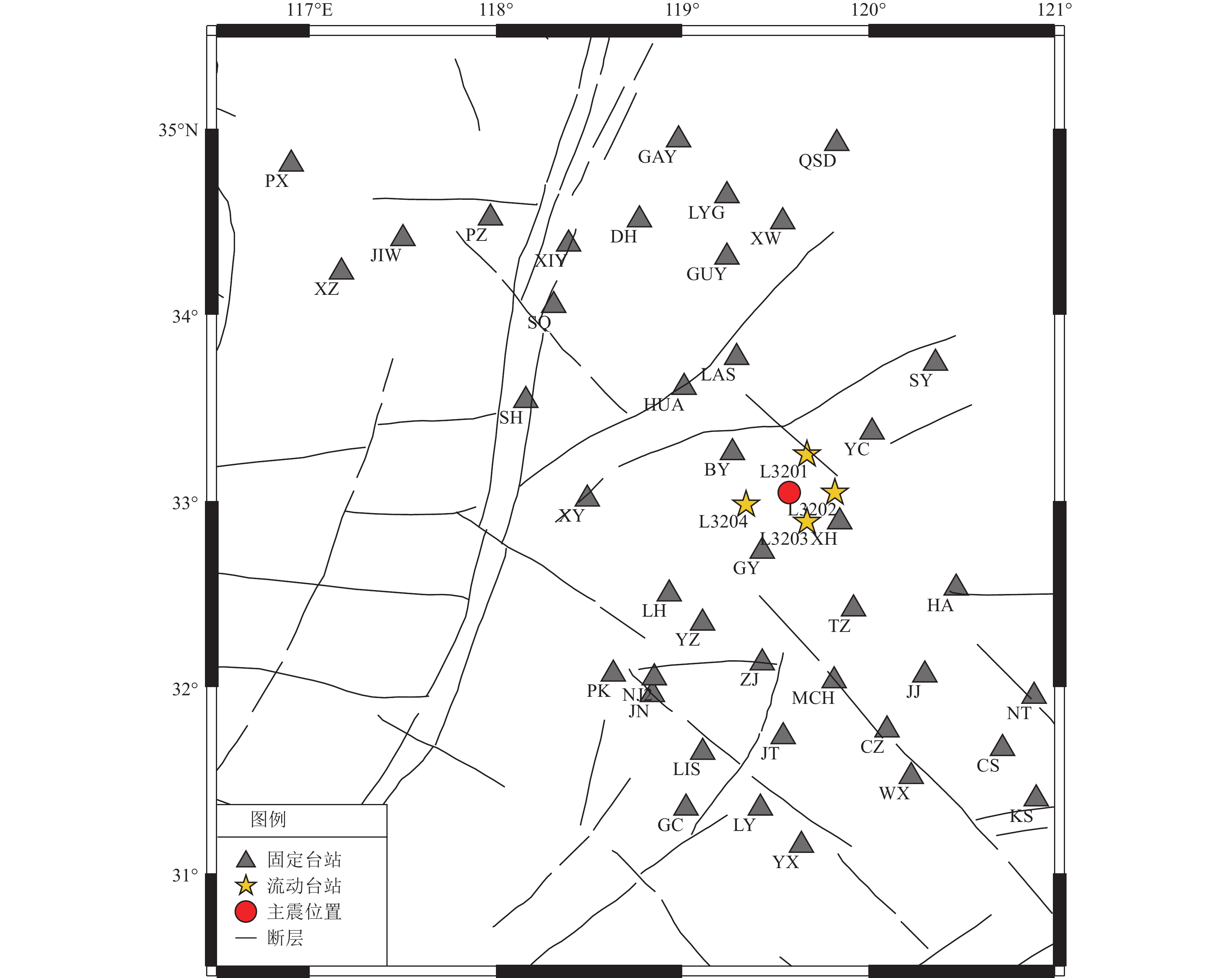
 下载:
下载:
